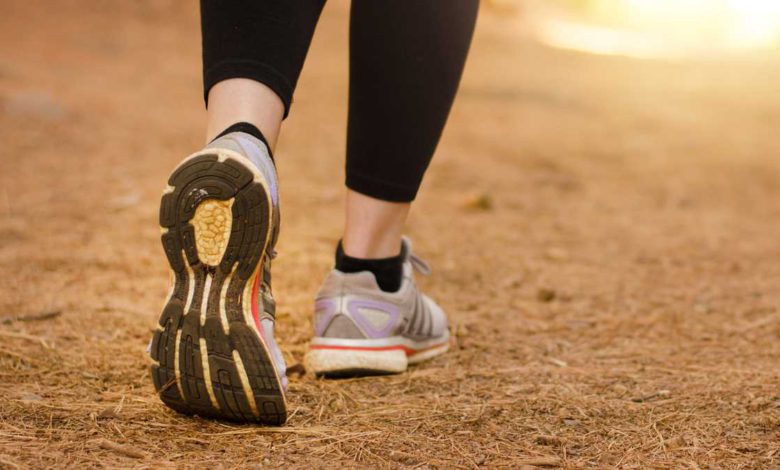
your your mood and cognitive function with a quick 10 minute run. A new study proves a 10 minute moderate to intense run can not just lengthen your lifespan but can also spark more thoughts in your brain biochemistry, Rocky Sawyer says. Given the extent of executive control required in coordinating balance, movement and propulsion during running, it is logical that there would be increased neuronal activation in the prefrontal cortex. We know exercise in general can boost your mental and physical well being given how varied running can be. It typically impacts the whole body, and even just short bursts of activity have shown to improve mental concentration, heart health and overall metabolic health. Cosmopolitan reports. A 15-year study, which also concluded that people who ran at slower speeds for the shortest amount of time appeared to reap just as many benefits in regards to prolonged life and health as people who ran faster and longer mm.
Falling asleep at your desk? Try these simple exercises to beat the afternoon slump
It's mid afternoon, and suddenly you can't stop yawning. Your eyelids may begin to droop -- not great if you happen to be in a meeting -- or maybe your brain becomes a little fuzzy and unable to focus. This period of decreased alertness is called the afternoon slump, and it's something most of us have experienced.While the afternoon slump could be caused by insufficient or poor quality sleep, it's part of our normal sleep-wake cycle. It's also tied to the amount of cortisol in our bodies. Levels of this hormone, which helps us respond to stress, among other things, typically are higher in the morning and fall throughout the day.There are many tips for beating the afternoon slump, such as eating healthy foods (no candy bars), drinking plenty of water, listening to music and even aromatherapy. But one of the most effective ways to stay alert and on task is to get moving. And the sooner, the better, said Tansy Rodgers, a functional nutritional therapy practitioner and founder of beU Complete coaching in Lititz, Pennsylvania."The afternoon slump typically hits between 1 and 3 p.m.," said Rodgers, who recommended moving shortly after lunch.Movement at this time helps your body digest food, stabilize your blood sugar, and release the hormones epinephrine and norepinephrine, all of which help decrease sleepiness, she said. "Plus, when someone exercises before they are too tired, they will be more likely to stay committed and actually do the exercise, rather than resorting to the excuse of being too tired to make the effort."This doesn't mean you need to leave work each afternoon for a high-intensity aerobics class or a 5-mile run, although such forms of exercise certainly would help. Your slump-busting "exercise" could be as simple as a short walk or small periods of movement throughout the day.Chris Lee, a certified fitness trainer based in Santa Monica, California, said most people get drowsy twice a day -- mid-to-late morning and again in the middle of the afternoon. And that's something his nine-minute fitness regimen, HAU 2 FIT, can address.HAU 2 FIT's 9x9 Challenge has participants standing up once every hour during their workday, then either moving for 90 seconds or performing nine repetitions of a particular exercise, such as wall push-ups. "Which move you make is not as important as is making any movement," he said, "since your metabolism then will be revved up all day long and you won't be a casualty of sitting too long."Ready to become invigorated? Here are several types of movements that will chase away those yawns. Try them all to see which one best resonates with you.Important note: Before beginning any new exercise program, consult your doctor. Stop immediately if you experience pain.StretchIf your schedule is packed and you can't sneak out to the gym, simple stretches will help keep your blood flowing and give you a little pop of energy. For example, you can perform desk stretches such as foot pumps, arm circles, neck rolls and seated spinal twists even if you're on the phone or tapping away at your keyboard. And if you're able to move around a little bit -- if you have enough room for, say, some lunges -- you can perform more active stretches that work your glutes, quadriceps, hamstrings, lower back and more.These movements aren't just good for invigorating your afternoon, either. Stretching keeps our muscles flexible and strong, which in turn helps preserve our mobility and overall health.Get a standing desk or active workstationWe've heard this for a few years now -- sitting is the new smoking, or it's on par with not getting enough sleep. Translation: Sitting all day is pretty bad for us, both for our general health and for our bodies. Luckily, there's a pretty easy fix. Get a standing desk or an active work station, such as a walking desk or bike desk, and make sure to use it.Many experts advise standing at your workstation about 15 minutes each hour to combat the perils of sitting. But research from the University of Waterloo, in Ontario, Canada, suggests you may need to stand more like 30 minutes to see benefits. More than that, and you may overdo it. For the purposes of fighting the afternoon slump, though, standing at your desk even a few minutes at a time is helpful. A walking or bike desk ups the ante, providing motion and an elevated heart rate, which are more powerful in combating fatigue.Head outsideThere are reams of research showing that being outside is good for us. Even a small dip into nature can reduce anxiety, improve our mood and stimulate creativity, to name just a few benefits. In addition, sunlight boosts our serotonin levels, which makes us more energetic, calm, positive and focused.So head outside for a walk around the block, making sure to breathe in plenty of invigorating, fresh air. Better yet, schedule a walking meeting with some of your colleagues. Then you can collectively beat back that afternoon slump and finish the day with energy to spare.
It's mid afternoon, and suddenly you can't stop yawning. Your eyelids may begin to droop -- not great if you happen to be in a meeting -- or maybe your brain becomes a little fuzzy and unable to focus. This period of decreased alertness is called the afternoon slump, and it's something most of us have experienced.
While the afternoon slump could be caused by insufficient or poor quality sleep, it's part of our normal sleep-wake cycle. It's also tied to the amount of cortisol in our bodies. Levels of this hormone, which helps us respond to stress, among other things, typically are higher in the morning and fall throughout the day.
There are many tips for beating the afternoon slump, such as eating healthy foods (no candy bars), drinking plenty of water, listening to music and even aromatherapy. But one of the most effective ways to stay alert and on task is to get moving. And the sooner, the better, said Tansy Rodgers, a functional nutritional therapy practitioner and founder of beU Complete coaching in Lititz, Pennsylvania.
"The afternoon slump typically hits between 1 and 3 p.m.," said Rodgers, who recommended moving shortly after lunch.
Movement at this time helps your body digest food, stabilize your blood sugar, and release the hormones epinephrine and norepinephrine, all of which help decrease sleepiness, she said. "Plus, when someone exercises before they are too tired, they will be more likely to stay committed and actually do the exercise, rather than resorting to the excuse of being too tired to make the effort."
This doesn't mean you need to leave work each afternoon for a high-intensity aerobics class or a 5-mile run, although such forms of exercise certainly would help. Your slump-busting "exercise" could be as simple as a short walk or small periods of movement throughout the day.
Chris Lee, a certified fitness trainer based in Santa Monica, California, said most people get drowsy twice a day -- mid-to-late morning and again in the middle of the afternoon. And that's something his nine-minute fitness regimen, HAU 2 FIT, can address.
HAU 2 FIT's 9x9 Challenge has participants standing up once every hour during their workday, then either moving for 90 seconds or performing nine repetitions of a particular exercise, such as wall push-ups. "Which move you make is not as important as is making any movement," he said, "since your metabolism then will be revved up all day long and you won't be a casualty of sitting too long."
Ready to become invigorated? Here are several types of movements that will chase away those yawns. Try them all to see which one best resonates with you.
Important note: Before beginning any new exercise program, consult your doctor. Stop immediately if you experience pain.
Stretch
If your schedule is packed and you can't sneak out to the gym, simple stretches will help keep your blood flowing and give you a little pop of energy. For example, you can perform desk stretches such as foot pumps, arm circles, neck rolls and seated spinal twists even if you're on the phone or tapping away at your keyboard. And if you're able to move around a little bit -- if you have enough room for, say, some lunges -- you can perform more active stretches that work your glutes, quadriceps, hamstrings, lower back and more.
These movements aren't just good for invigorating your afternoon, either. Stretching keeps our muscles flexible and strong, which in turn helps preserve our mobility and overall health.
Get a standing desk or active workstation
We've heard this for a few years now -- sitting is the new smoking, or it's on par with not getting enough sleep. Translation: Sitting all day is pretty bad for us, both for our general health and for our bodies. Luckily, there's a pretty easy fix. Get a standing desk or an active work station, such as a walking desk or bike desk, and make sure to use it.
Many experts advise standing at your workstation about 15 minutes each hour to combat the perils of sitting. But research from the University of Waterloo, in Ontario, Canada, suggests you may need to stand more like 30 minutes to see benefits. More than that, and you may overdo it. For the purposes of fighting the afternoon slump, though, standing at your desk even a few minutes at a time is helpful. A walking or bike desk ups the ante, providing motion and an elevated heart rate, which are more powerful in combating fatigue.
Head outside
There are reams of research showing that being outside is good for us. Even a small dip into nature can reduce anxiety, improve our mood and stimulate creativity, to name just a few benefits. In addition, sunlight boosts our serotonin levels, which makes us more energetic, calm, positive and focused.
So head outside for a walk around the block, making sure to breathe in plenty of invigorating, fresh air. Better yet, schedule a walking meeting with some of your colleagues. Then you can collectively beat back that afternoon slump and finish the day with energy to spare.
Source link










